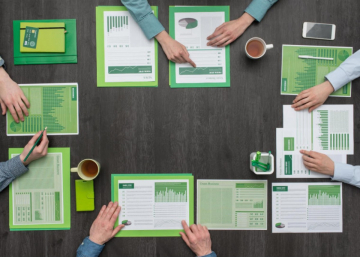Materiality is a growing topic in the corporate sustainability world. CSR teams work hard to meaningfully convey the opportunities and successes of their initiatives to internal and external stakeholders.
To bring insight and focus to their work, many are utilizing materiality assessments.
If you’re considering conducting a materiality assessment, below we offer seven basic steps that should be a part of your initiative:
- Identify Internal and External Stakeholders
- Conduct Initial Stakeholder Outreach
- Identify and Prioritize What You Want to Measure
- Design Your Materiality Survey
- Launch Your Survey and Start Collecting Insights
- Analyze the Insights
- Put Insights into Action
What is a Materiality Assessment?
Before we get started, its important to define the term. Materiality assessments are formal exercises aimed at engaging stakeholders to find out how important specific environmental, social and governance (ESG) issues are to them. The resulting material matrix is a visualization of the insights gained. It can be used to guide business strategy and communication. This helps you tell a more meaningful sustainability story in the long term.
Watch the video below for an overview of materiality assessments.

Defining Stakeholders & (ESG) Materiality Priorities
1. Identify internal and external stakeholders
Successful materiality assessments are most valuable when you’re able to gather diverse insights from inside and outside company walls.
Begin the materiality process by creating a list of relevant stakeholder groups, then identify key contacts within each who can provide a meaningful perspective on your company’s sustainability strategy. Take into account both internal (i.e., executive leadership, directors, regional managers, employees) and external contacts (i.e., trade associations, key customers, NGOs) so you can evaluate a wide range of perspectives across the value chain.
2. Conduct some initial stakeholder outreach
Once you’ve zeroed in on who you’d like to engage, get in touch with them early on to set the stage and let them know you want their participation.
Keep your pitch as concise as possible without leaving out essential details. Your objective should be to express to the participant group why their unique insights are valuable and how their insights will be used to guide your company’s sustainability strategy and business practices.
3. Identify and prioritize what you want to measure
Once you’ve identified and engaged with stakeholders, determine what sustainability indicators to measure so you actually get the insights you want and need. Sustainability indicators are often categorized in three ways:
- Economic (e.g., revenue, profit, company turnover)
- Social (e.g., labor statistics, human rights, consumer issues, community impact)
- Environmental (e.g., water stewardship, greenhouse gas emissions, waste management)
Use data you’ve already collected, any initial insights stakeholders have provided, media research, and other resources such as GRI, SASB, and CSR Europe to determine which indicators are most relevant to your business.
Your Materiality Assessment Survey
4. Design your materiality survey
To get the best results, materiality assessments should be formal, structured engagements with stakeholders—not informal Q&As or workshops. We suggest using a traditional survey format to make it easy for stakeholders to complete and easy for you to analyze results.
In the survey, ask stakeholders to rate the importance and impact of each indicator you’ve identified on a numerical scale, such as 1-5 or 1-10. This will give you quantitative data that can be analyzed and explained visually. Leave additional space for written insights and comments to enhance the results you receive.
Once you have the content and design of your survey complete, you need to put it into a form that is easily accessible and simple to complete. Consider investing in software that can streamline collection and reporting, or utilize surveying tools such as Survey Monkey, Typeform, or Google Forms.
5. Launch your survey and start collecting insights
Now that you've identified your influencers, engaged with them, and created your survey questions, it's time to invite people to take your survey.
Reach back out to your stakeholders and provide them with the link to the survey and a deadline. In addition, make sure to thank them for their willingness to participate, and offer to be a resource for any questions they may have. When the deadline approaches, reach back out to those who have yet to complete the survey to remind them of the deadline.
Evaluate & Synthesize Materiality Survey Responses
6. Analyze the insights
You’ve worked hard to gather these insights, and now it’s time to draw some meaning from them.
Review all of the results collectively, rolling up rankings according to the reviewed indicator. You can create different roll-ups depending on the stakeholder group (e.g. internal vs. external rating, management vs. employee ratings, etc.) Make sure to review specific comments, because the comments are often where the most value is derived.
Analyze insights individually to determine what issues are most important to each stakeholder group. In addition, bring all the data together to find commonalities. You can create several graphs to help map out trends and observations, but the end result should be a formal matrix graph that plots how each indicator ranks in significance relative to stakeholder influence.
7. Put those insights into action
While materiality assessments are certainly an exercise in stakeholder engagement, the engagement shouldn’t end after they complete the survey.
Share your results and insights with your stakeholders (and beyond!). This is typically done in a formal sustainability report or summary, but then can be shared more widely through other channels, such as the company website or media releases.
Sharing your materiality assessment results can serve as a starting point for continuing the conversation and maintaining engagement with your sustainability initiatives. Welcome feedback from all stakeholders who view your materiality assessment results so you can keep the conversation flowing after the assessment is complete. In addition, incorporate your findings into your overall sustainability strategy so you can create communications plans for each group, and more effectively tell your company’s sustainability story.
While a materiality assessment requires time, effort and resources, it’s an invaluable tool for gathering insights that can drive your sustainability strategy and enable meaningful reporting. Conducting a materiality assessment is also the first step in our process to developing an ESG strategy.
Learn more about materiality assessments as well as other corporate sustainability reporting and disclosure services that Antea Group can provide.
Download Our 7 Steps List Here!
- 7 Steps For Conducting a Materiality Assessment Download
Want more news and insights like this?
Sign up for our monthly e-newsletter, The New Leaf. Our goal is to keep you updated, educated and even a bit entertained as it relates to all things EHS and sustainability.
Get e-NewsletterHave any questions?
Contact us to discuss your environment, health, safety and sustainability needs today.









